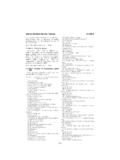Transcription of OECD releases final transfer pricing guidance on risk and ...
1 EY OECD BEPS projectStay up-to-date on OECD s project on Base Erosion and Profit Shifting with EY s online site containing a comprehensive collection of resources, including news, Alerts and comment letters. Copy into your web browser: Global Tax Alert LibraryAccess both online and pdf versions of all EY Global Tax Alerts. Copy into your web browser: #dateGlobal Tax AlertNews from transfer Pricing13 October 2015 OECD releases final transfer pricing guidance on risk and recognition under Actions 8 10 Executive summaryOn 5 October 2015, the Organisation for economic Co-operation and Development (OECD) released its final report on aligning transfer pricing outcomes with value creation (Actions 8 10) under its Action Plan on Base Erosion and Profit Shifting (BEPS).
2 This report was released in a package that included final reports on all 15 BEPS document Aligning transfer pricing Outcomes with Value Creation (the final Report), contains revisions to section D of Chapter I of the OECD transfer pricing Guidelines, guidance on commodity transactions, revisions to Chapter VI of the OECD transfer pricing Guidelines regarding intangibles, revisions to Chapter VII of the OECD transfer pricing Guidelines regarding low value-adding intra-group services, revisions to Chapter VIII of the OECD transfer pricing Guidelines regarding cost contribution arrangements.
3 And scope of work for guidance on the transactional profit split Alert discusses the revisions to section D of Chapter I of the OECD transfer pricing Guidelines relating to risk analysis, recognition of the accurately delineated transaction, and cash key guidance includes: The importance of accurately delineating the actual transactions between associated enterprises through analyzing the contractual relations together with evidence of the actual conduct of the parties. Detailed guidance on analyzing risks as an integral part of a functional analysis, including a new six-step analytical framework.
4 For transfer pricing purposes, the party assuming a risk should control the risk and have the financial capacity to assume the Tax Alert transfer pricing2 A capital-rich multinational enterprise (MNE) group member without any other relevant economic activities that provides funding, but cannot control financial risks in relation to the funding, will attain no more than a risk-free return (and less if the transaction is commercially irrational). In exceptional circumstances of commercial irrationality, a tax administration may disregard the actual transaction.
5 The main question is whether the actual transaction has the commercial rationality of arrangements that would be agreed between unrelated parties under comparable economic final Report contains significant changes compared to the discussion draft on risk and recharacterization in December 20141 and compared to the 2010 OECD transfer pricing is hosting a series of webcasts that will provide a comprehensive review of the final BEPS reports and outlook for country action. The final report on Actions 8 10 will be addressed in a webcast on transfer pricing and BEPS Actions 8 10, on 12 November, 10am discussionBackgroundBEPS Actions 8, 9 and 10 relate to assuring that transfer pricing outcomes are in line with value creation.
6 This includes the development of rules on a number of closely related topics, including:1. Development of rules to prevent BEPS by transferring risks among, or allocating excessive capital to, group members2. Development of rules to prevent BEPS by engaging in transactions that would not, or would only very rarely, occur between third parties, including implementing transfer pricing rules or special measures to clarify the circumstances in which transactions can be recharacterized3. transfer pricing rules or special measures for transfers of hard-to-value intangiblesThe final Report contains specific revisions to section D of Chapter I of the OECD transfer pricing Guidelines following work under BEPS Actions 9 and 10.
7 To deal with the perceived focus on contractual allocations of functions, risks and assets under the current guidance , the final Report provides that the revisions clarify and strengthen the guidance on the arm s length principle to ensure that transfer pricing outcomes are consistent with the economic activity conducted by MNE group members. The report highlights the importance of accurately delineating the actual transactions, provides a new six-step framework to determine which party assumes risk and updates the guidance on recognition of the accurately delineated transaction, including criteria for determining when it would be appropriate for the actual transaction not to be the commercial or financial relationsThe final Report extends the comparability analysis, an important element of a transfer pricing analysis, with an important first step.
8 The final Report notes two aspects of a comparability analysis: (i) the identification of the commercial or financial relations between the associated enterprises and the conditions and economically relevant circumstances attaching to those relations in order that the controlled transaction is accurately delineated; and (ii) a comparison between the conditions and the economically relevant circumstances of the controlled transaction as accurately delineated, with the conditions and the economically relevant circumstances of comparable transactions between independent enterprises.
9 The first aspect is dealt with in Chapter I of the OECD transfer pricing Guidelines, while Chapters II and III focus on the second final Report states that the economically relevant characteristics or comparability factors of a transaction between associated enterprises should be identified in order to accurately delineate the actual transaction. These comparability factors can be broadly categorized as follows: (i) contractual terms, (ii) functions performed taking into account assets used and risks assumed, (iii) characteristics of property and services, (iv) economic circumstances of the parties and market, and (v) business Tax Alert transfer pricingWhere a transaction has been formalized by the taxpayer through written contractual agreements, those agreements provide the starting point for identifying the commercial and financial relations between the associated enterprises.
10 However, information from the written contracts should be clarified and supplemented by considering evidence of the commercial and financial relations provided by the other four economically relevant characteristics. An analysis of all five characteristics provides evidence of the actual conduct of the parties. In case the economically relevant characteristics of a transaction are inconsistent with contractual terms, the actual transactions should in general be identified based on the actual conduct of the parties. The final Report provides that where no written terms exist, the actual transaction would need to be deduced from the evidence of actual conduct provided by identification of the economically relevant characteristics of the final Report includes additional guidance regarding the functional analysis, which should focus on what the parties actually do and the capabilities they provide.
















